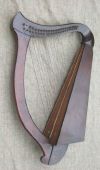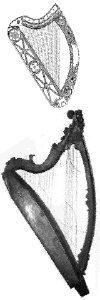

|
Since the middle of the 20th century, if not before, people have wanted to get the old Gaelic harp traditions up and running again, and so as part of this they have had to experiment with what wires work well on a replica harp.

Not all of these experimenters have used replica harps - James McFall, for example, working in Belfast in the early 20th century, seems to have tried using iron or steel strings on a harp of modern design1. Plenty of other people redesign the instrument with different string lengths and structures to suit modern commercially available wires. Nothing wrong with that of course, but it is a different path from what I am seeking for here.
From an “early music” point of view, as well as from an “experimental archaeology” position, the most interesting results come from using a harp that is as accurate a replica as possible of one of the museum instruments, and using stringing and tuning copying as honestly as possible the historical and archaeological evidence. Some people have been doing this2 but it is hard work and there is a lot of choices that still have to be made! From my point of view, the sounds and possibilities that emerge from this work are fascinating and compelling, and I find it far from a dry and dusty academic ecercise. I believe the old harpmakers and players were true masters of their arts, and this work is an attempt to find the echoes and shadows of what they did.

The first thing that becomes very obvious when you start working with good replicas copied from the old museum instruments is that there are two very dfferent shapes or styles3. The older style, exemplified by the medieval Trinity College harp and the Queen Mary harp, has been labelled ‘small low-headed’. With 29 or more strings, these harps are relatively small and have comparatively short bass strings.
The later harps, exemplified by the 18th century Downhill harp, or the Kildare harp, are termed ‘high-headed’. They do not necessarily have more strings (though some do), but they are taller and have much longer bass strings.
The proportional increase in length from treble to bass is called ‘scaling’ This is an issue that is very familiar to people working with harpsichords, where we have similar issues - museum instruments that need to be strung and tuned in an experimental way, to discover their original configuration and sound through trial and error. We can learn a lot from talking to harpsichord people about how they work and the issues that they face.
Many harpsichords use more than one type of metal, typically iron in the treble and brass in the bass. An instrument designed for this configuration can not easily be strung with just one metal, because the scaling will cause problems in the treble or in the bass. We know from the history and archaeology of the Gaelic harp that at least some of the old instruments were strung with two metals: sources mention iron and brass, or brass and silver. These would be used for treble and bass respectively - the softer, denser metal is always put lower in the range than the harder lighter one.
There are also descriptions of harps which don’t mention two metals, usually just saying that brass is the metal used. I don’t know whether they didn't bother mentioning the second metal.
In my experience, the big 18th century ‘high headed’ harps can be strung very satisfactorily using brass for the whole range. However I am not convinced that this is a suitable regime for a medieval ‘small low-headed’ harp. No matter how much account you take of tensile pick-up4, or unusual tunings, a single-metal scheme is really pushing it for these instruments. Two metals seems a much more obvious solution, and it is even possible to use three5.
At the present time it is not possible to state definitively what is the correct regime for a medieval ‘small low-headed’ harp, though I think we can be a lot more confident that we understand the stringing and setup of the 18th century ‘high headed’ harps fairly well.
1. McFall small wire-strung harp owned by the Historical Harp Society of Ireland, online at irishharp.org and also at simonchadwick.net. Wire stringing of McFall harps is mentioned by James O'Laverty, “The Irish harp”, in Denvir’s Monthly, 1903. ^
2. The most comprehensive report to date is Daniel Tokar and Ann Heymann, Dialogue on Historical Wire for Gaelic Harps, 2011 ^
3. Joan Rimmer devised the 3-fold classification of ‘low headed’, ‘large low headed’ and ‘high headed’ in her article The morphology of the Irish harp, "Galpin Society Journal" no. 17, 1964. The ‘large low headed’ harps are the least easy to understand for me, they are hardest to date, and half of them are incomplete. Rimmer herself did not entirely understand the implications and details of her system at the time. ^
4. Paul Dooley, ‘Reconstructing the medieval Irish harp’, Galpin Society Journal LXVII, 2014^
5. Ann and Charlie Heymann, Strings of Gold, in "Journal of the Historical Harp Society", Summer 2003, were I think the first to really get to grips with this issue. online at annheymann.com. ^